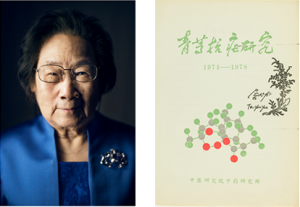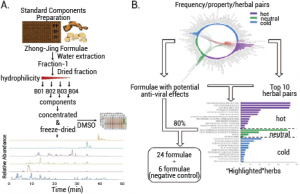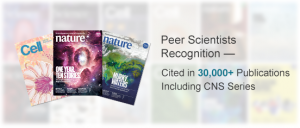30 May [MCE] High-throughput Screening and Traditional Chinese Medicine

Traditional Chinese Medicine – An Important Resource for Drug Discovery
Traditional Chinese medicine (TCM) is a holistic natural medicine system with thousands of years’ history [1]. According to the third national resource survey of traditional Chinese medicine materials (TCMMs), there are 12,807 kinds of materials used as TCMM, including 11,116 plant derived materials, 1,571 animal derived materials, and 80 kinds of minerals [2]. Most of these TCMMs have been used for hundreds or even thousands of years, and their efficacies and toxicities are well documented. Although the principal bioactive ingredients in many TCMMs and their underlying therapeutic mechanisms remain largely unknown, this unique national heritage has become a rich resource for drug discovery in modern times.
Active substances can be extracted from Traditional Chinese Medicine
Isolated from medicinal plants or traditional Chinese medicine formulas, active ingredients are defined as a set of compounds or fractions with known chemical composition, reproducible pharmaceutical properties and clinical efficacy. At Shanghai Institute of Materia Medica, more than 6,000 single chemical entities with novel structures have been identified from TCM since the 1950s, and several of them have been developed into clinical candidates or approved medicines, such as artemether, salvicine, huperzine A, and depside salts from Saliva Miltiorrhiza [3]. The 2015 Nobel Prize in Physiology or Medicine was awarded to Youyou Tu in recognition of her contribution in the discovery of artemisinin as an effective antimalarial medicine.

Figure 1. Youyou Tu, the 2015 Nobel Laureate in Physiology or Medicine [4]
High-throughput Screening using Traditional Chinese Medicine
Active Compound Library
Traditional Chinese Medicine Active Compound Library can be a useful tool for discovering new drugs. Recent progress made in separation and preparation of traditional Chinese medicine constituents not only added more potential lead compounds to the TCM active compound collection, it also significantly increased the chemical diversity of the available TCM active compounds. In a recent study, researchers rationally selected 30 TCM formulas from 200 anti-viral formulas collected in the ancient Chinese medicine book “Treatise on Febrile and Miscellaneous Diseases”, and prepared a 1306-fraction herbal formulae extract library by standardized chromatographic fractionation. The antiviral activity of this library was screened using HEK293T cells carrying a luciferase-driven interferon stimulated response element (ISRE). Hit compounds were identified by liquid chromatography mass spectrometry analysis, their mechanisms of action were also explored. A total of 18 ISRE-activating fractions were found, and three compounds, ononin, sec-O-β-D-glucosylhamaudol and astragaloside I, were shown to activate ISRE through their impacts on p65 phosphorylation and nuclear translocation [5].

Figure 2. Preparation and statistics of traditional Chinese medicine sublibrary [5]
MedChemExpress
provides a series of TCM/natural product derived compound libraries:
| Product Name | Description |
| HY-L065 Traditional Chinese Medicine Active Compound Library |
A unique collection of 2,700+ active compounds in Chinese Herbal Medicines. MCE Traditional Chinese Medicine Active Compound Library is a useful tool for discovering new drugs from TCM. |
| HY-L113 Antiviral Traditional Chinese Medicine Active Compound Library |
A unique collection of 200+ active compounds of antiviral Chinese Herbal Medicines. MCE Antiviral Traditional Chinese Medicine Active Compound Library is a useful tool for discovering antiviral drugs from TCM. |
| HY-L114 Anti-inflammatory Traditional Chinese Medicine Active Compound Library |
A unique collection of 1,000+ Traditional Chinese Medicine active compounds with anti-inflammatory activity, derived from Coptis chinensis, Radix isatidis, Flos Lonicerae, Forsythia suspensa, etc. MCE Anti-inflammatory Traditional Chinese Medicine Active Compound Library is a useful tool for discovering anti-inflammatory drugs from TCM. |
| HY-L115 Plant-Sourced Natural Product Library |
A unique collection of 2,600+ plant-sourced natural products. |
| HY-L055 Medicine Food Homology Compound Library |
A unique collection of 1,600+ Medicine Food Homology Compounds with good safety profiles designed based on data released by Chinese National Health Commission. |
| HY-L021P Natural Product Library Plus |
A unique collection of 4,400+ natural compounds that contain Saccharides and Glycosides, Phenylpropanoids, Quinones, Flavonoids, Terpenoids and Glycosides, Steroids, Alkaloid, Phenols, Acids and Aldehydes. |
| HY-L056 Terpenoids Library |
A unique collection of 600+ terpenoid related natural products. MCE Terpenoids Library is a useful tool for drug discovery that can be used for high-throughput screening (HTS) and high-content screening (HCS). |
| HY-L057 Phenols Library |
A unique collection of 1,000+ natural phenol compounds which contain resourceful lead compounds and provide useful tools for drug discovery. |
| HY-L068 Flavonoids Library |
A unique collection of 400+ natural flavonoid compounds which contain resourceful lead compounds and provide useful tools for drug discovery. |
| HY-L071 Alkaloids Library |
A unique collection of 400+ alkaloids natural products. MCE Alkaloids Library is a useful tool for drug discovery and can be used for high-throughput screening (HTS) and high-content screening (HCS). |
| HY-L107 Anti-Cancer Natural Product Library |
A unique collection of 1,400+ natural products with validated anti-cancer activity. MCE anti-cancer natural product library is a useful tool for anti-tumor drug screening and other related research. |
| HY-L134 Anti-Aging Natural Product Library |
A unique collection of 200+ natural products with validated anti-aging activity. MCE anti-aging natural product library is a useful tool for the study of aging-related diseases and drug discovery. |
| HY-L021L Natural Product-like Compound Library |
A unique collection of 500+ natural product-like compounds that are structurally close to Steroids, Tannins, Flavonoids, Quinones, Isoquinolines, etc. This library is an important source of lead compounds for drug discovery. |
More compound libraries are available:
https://www.medchemexpress.com/screening-libraries.html
References:
[1] Front. Pharmacol, 8 (2017), pp. 1-5.
[2] Zhongguo Zhong Yao Za Zhi. 2014 Dec;39(24):4728-31.
[3] Comb Chem High Throughput Screen. 2010 Dec;13(10):837-48.
[4] Nobel Prize in Physiology or Medicine in 2015.
[5] Pharmacol Res. 2019 Jul;145:104248.

Request Your Quote


